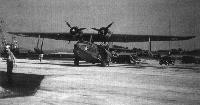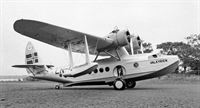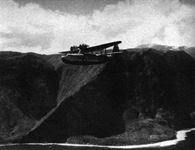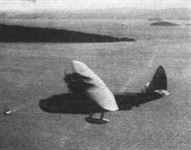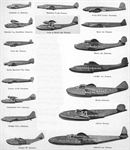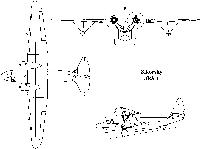
Описание
Страна : США
Год : 1936
Летающая лодка
15-местная пассажирская летающая лодка
S-43 Baby Clipper/JRS/Y1OA-8
Амфибия, двухмоторный цельнометаллический моноплан-парасоль. Создан в отделении "Сикорски эйркрафт" корпорации "Юнайтед эйркрафт" под руководством И.И. Сикорского. Военный вариант пассажирской амфибии S-43 "Бэби клиппер", проходившей испытания в 1935 г. Серийное производство S-43 начали в 1936 г. В следующем году стали строить варианты этой амфибии, принятые на вооружение армейской и морской авиации США. Всего вооруженные силы получили 23 машины этого типа.
Строились следующие военные модификации:
- JRS-1 с моторами R-1690-52 для авиации флота, военно-транспортный самолет на 19 мест, в войну устанавливались бомбодержатели для глубинных бомб (весом до 225 кг);
- Y1OA-8 с моторами R-1690-23 для армии, грузовой самолет без сидений в салоне;
- OA-11, реквизированный армией пассажирский S-43 с моторами R-1690-S2C.
Стрелкового вооружения ни один самолет не имел.
В предвоенные годы машины семейства S-43 эксплуатировались американскими армией, флотом и морской пехотой. В 1942 г. JRS-1 привлекались к противолодочному патрулированию у западного побережья США и Гавайских о-вов, но в основном все эти машины летали как транспортные.
Последний самолет (OA-11) был приобретен армией в марте 1942 г. JRS-1 для флота прекратили строить в 1939 г.
Морская авиация США сняла JRS-1 с вооружения в конце 1942 г., ВВС армии - в конце 1945 г.
Чилийские ВВС эксплуатировали два S-43 гражданского варианта до конца 1938 г.
JRS-1||
Размах:||26,21 м
Длина:||15,7 м
Моторы, количество х мощность:||2х 750 л.с.
Взлетная масса, максимальная:||8850 кг
Максимальная скорость:||285 км/ч
Практический потолок:||6300 м
Дальность:||4000 км
Описание:
- S-43 Baby Clipper/JRS/Y1OA-8
- Sikorsky S-43
- Flight, June 1935
AMERICA'S LATEST AMPHIBIAN
Фотографии
-
Aviation Historian 19 / R.Mulder - Pole position
Регистрационный номер: LN-DAG [9] The colour scheme used for Valkyrien was simple but attractive, the upper fuselage retaining a natural-metal finish while the lower fuselage, hull, undersurfaces of the floats and engine nacelles were painted in a medium green. The fin sported the Norwegian flag below DNL’s logo.
-
Aeroplane Monthly 1996-04
Регистрационный номер: N440 [3] GORDON BAIN photographed Ron van Kregtem's Sikorsky S-43W, N440, on May 29 last year. The aircraft was en route from Watsonville to Bakersfield, California, on the first leg of its journey back to Houston, Texas, after appearing at the 31st Annual West Coast Fly-in and Airshow. The Sikorsky used to be owned by Howard Hughes.
-
Aeroplane Monthly 1994-12 / Oshkosh 1994
Регистрационный номер: N440 [3] This Sikorsky S-43 was once owned by Howard Hughes.
-
Моделист-Конструктор Гидросамолеты Второй мировой войны
Амфибия S-43 (США) - единственный сохранившийся до наших дней экземпляр
-
Aviation Historian 19 / R.Mulder - Pole position
Регистрационный номер: NC15061 The prototype of the attractive S-43, NC15061, during an early test flight. Three main variants were produced; the single-fin Pratt & Whitney Hornet-engined S-43A and a similarly-powered twin-finned version, the S-43B, which was usually delivered as a flying-boat and operated from water only. The final variant, the S-43W, was powered by Wright Cyclones.
-
Jane's All the World Aircraft 1938 / 03 - All the world's aeroplanes
Регистрационный номер: NC15063 The Sikorsky S-43 Commercial Amphibian (two 750 h.p. Pratt & Whitney "Hornet" engines).
-
Flight 1937-04 / Flight
SEA LAWYER AND WARRIOR: A contrast in shapes and sizes is offered by this pose of a Vought V-143 single-seater fighter in the shade of a Sikorsky S-43 amphibian. The V-143 does 280 m.p.h. with a P. and W. Twin Wasp Junior and the amphibian 190 m.p.h. with two Hornets.
Другие самолёты на фотографии: Vought V-141 / V-143 / V-150 / Northrop 3A - США - 1935
-
Мировая Авиация 236
Регистрационный номер: NC15064 Меньший по размерам S-43 часто называли "Mini Clipper" или "Baby Clipper". Характеристики его были в целом схожи с S-42.
-
Aviation Historian 19 / R.Mulder - Pole position
Регистрационный номер: F-AQHY One of several S-43 amphibians operated by Compagnie des Chargeurs Reunis, which formed its own airline, Aeromaritime, in the early 1930s, to operate scheduled services along the West African coast, from Dakar in Senegal to Pointe Noire in French Equatorial Africa (now the Republic of Congo).
-
Jane's All the World Aircraft 1938 / 01 - The progress of the world in civil aviation during the year 1937-38
INTERNATIONAL AMITY. - Passengers, at Accra, enter an American Sikorsky S/43 (two 750 h.p. Pratt & Whitney "Hornets") which belongs to the Cie. Aeromaritime, by a hatch aft, with the help of steps.
-
Авиация и Время 2014-05 / И.Бабенко - Летчик, авиаконструктор, ученый (Герой Советского Союза А.Н.Грацианский)
Экипаж самолета-амфибии S-43. Третий справа - А.Н. Грацианский. Аляска, сентябрь 1937 г.
-
Flight 1935-06 / Flight
This is the first photograph taken of the new Sikorsky S.43, which, although it is an amphibian, can carry fifteen passengers and 550 lb. of mail for a distance of 1,000 miles at 165 m.p.h.
-
Jane's All the World Aircraft 1938 / 01 - The progress of the world in civil aviation during the year 1937-38
FRANCE TAKES BRITISH TRADE. - An American Sikorsky of the Cie. Aeromaritime on the runway at Accra.
-
Aeroplane Monthly 1989-09 / M.Oakey - Grapevine
Регистрационный номер: N440 [3] Photographed on July 14, 1989 at Wolfe Airpark in Manvel, Texas, is Sikorsky S-43H N440. Once owned by Howard Hughes, it is being restored to flying condition.
-
Jane's All the World Aircraft 1938 / 01 - The progress of the world in civil aviation during the year 1937-38
IN FRENCH GUINEA. - Refuelling at the excellent new aerodrome at Conakry for the 415-mile stage to Dakar.
-
Моделист-Конструктор Гидросамолеты Второй мировой войны
Амфибия JRS-1 из эскадрильи VJ-4 на аэродроме в Майями, февраль 1943 г.
-
Flight 1939-03 / Flight
The Sikorsky amphibian is a type used by the U.S. Army and Navy for general transport duties.
-
Flight 1936-09 / Flight
Регистрационный номер: LN-DAG [9] The now famous Sikorsky S.43 amphibian, this particular version of which having been sold for work in Norway, where the type should be particularly valuable.
-
Aviation Historian 19 / R.Mulder - Pole position
Регистрационный номер: LN-DAG [9] The DNL S-43A on home soil at Gressholmen, the seaplane port at Oslo. Seating in the S-43 was usually arranged for three crew and 16 passengers, but a coach-style configuration could accommodate up to 25. Military variants were operated by the US Army Air Corps as the OA-8 and by the US Navy and Marine Corps as the JRS-1.
-
Aviation Historian 19 / R.Mulder - Pole position
Регистрационный номер: LN-DAG [9] Valkyrien bound for New York aboard a steamer in August 1936. On the far right is Bernt Balchen and second from the left is Chris Braathen, who did much of the liaison work between DNL and Sikorsky. Sadly he was killed in a crash in 1937.
-
Aviation Historian 19 / R.Mulder - Pole position
Регистрационный номер: LN-DAG [9] Looking considerably more modern than its contemporary, Valkyrien shares parking space with UK airline International Air Freight’s Curtiss Condor G-AEZE at Amsterdam, where the S-43 was overhauled by Dutch airline KLM before being delivered to French shipping company Compagnie des Chargeurs Reunis in 1937.
Другие самолёты на фотографии: Curtiss Condor 18 - США - 1929
-
Aviation Historian 19 / R.Mulder - Pole position
Регистрационный номер: LN-DAG [9] Following the cancellation of the trans-atlantic trial flights in the summer of 1936, Valkyrien was used for a month on DNL’s Oslo-Stockholm service, and is seen here moored at the jetty at Gressholmen. Despite the advantages of operating a type that could take off from Bromma’s concrete runway and land on water at Oslo, DNL’s directors showed little enthusiasm for it.
-
Flight 1937-04 / Flight
Регистрационный номер: LN-DAG [9] AMPHIBIOUS COLLABORATION: When D.N.L. eventually work on the Newcastle-Stavanger service it is probable that a Sikorsky S.43 will be used. This photograph shows the company's first machine of this type at Stavanger. In the foreground, with D.N.L.'s agent, is Mr. Bernt Balchen, the famous pilot.
-
Aviation Historian 19 / R.Mulder - Pole position
Регистрационный номер: LN-DAG [9] Sikorsky S-43 amphibian LN-DAG, named Valkyrien, flies over Beerum, south of Oslo, during the aircraft’s short tenure with DNL during 1936-38. The "Baby Clipper", as the type was known, first flew in 1935 and in April 1936 set a world altitude record for amphibious aircraft when pilot Boris Sergievsky and designer Igor Sikorsky reached 27,950ft (8,520m) during a flight from Stamford, Connecticut.
-
Aviation Historian 19 / R.Mulder - Pole position
Регистрационный номер: LN-DAG [9] Valkyrien on its first flight over Oslo in 1936. Despite DNL’s misgivings about the type, based more on the financial burden it represented than its capabilities as an airliner, it proved popular with other operators in Hawaii, Alaska, Brazil, Chile, France, Russia and China.
-
Flight 1939-08 / Flight
Inter-Island Airways, the transport company linking the Sandwich group, use Sikorsky S.43 amphibians, one of which is seen flying over the coastline of Hawaii. The apparently bare and gloomy rock is, in fact, a mass of vegetation.
-
Flight 1938-06 / Flight
The Sikorsky S.43 in flight near Oslo; this machine was originally purchased for a projected service to America via Iceland.
-
Flight 1937-10 / Flight
HONOLULU BOUND: Such a prosaic excrescence as the wing-tip float of a Sikorsky S.43, used on the Hawaiian inter-island service, assumes a dramatic aspect against this Pacific background.
-
Aviation Historian 19 / R.Mulder - Pole position
Регистрационный номер: NC16927 The Norwegian airline expected to be allocated an S-43 from the PAA order (one of which, twin-finned S-43B NC16927, is seen "on the step").
-
Aviation Historian 19 / R.Mulder - Pole position
The prototype S-43 under construction at the Sikorsky factory at Bridgeport, Connecticut. The single biggest operator of the type was PAA and its Pacific and Latin American affiliates, which found the type eminently suitable for their needs.
-
Aeroplane Monthly 1990-01 / P.Chinnery - Tucson news
The Pima Air Museum obtained the Sikorsky JRS-1 twin-engined amphibious flying-boat from the US Marine Corps in 1985. It crashed in 1958 while flying with Hawaiian Airlines, and restoration work began in 1986.
-
Aviation Historian 19 / R.Mulder - Pole position
A poor-quality image of DNL and PAA representatives during a meeting in Oslo in February 1937, including Hjalmar Riiser-Larsen (far left), Rudolf Olsen (second left) and Bernt Balchen (furthest right).
-
Aviation Historian 19 / R.Mulder - Pole position
A rare DNL timetable for the summer of 1937, prominently featuring the airline’s most recent acquisition on the outer flap. The S-43 was little used, however, and, by the time this timetable was issued, considerable efforts were being made to find a new owner for it.
-
Flight 1938-04 / Flight
Другие самолёты на фотографии: Bloch MB.160 Languedoc - Франция - 1937Boeing Boeing 314 Clipper - США - 1938Consolidated PBY Catalina - США - 1935Dewoitine D.332 / D.333 / D.338 / D.620 - Франция - 1933Douglas DC-3 / C-47 Skytrain/С-53 Skytrooper / Dakota - США - 1935Douglas DF - США - 1936Focke-Wulf FW.200 Condor - Германия - 1937Junkers Ju.86 - Германия - 1934Latecoere Late 631 - Франция - 1942Liore et Olivier LeO H.246 - Франция - 1937Lockheed Super Electra 14 - США - 1937Martin Russian Clipper / Type 156 - США - 1937Potez Potez 661 - Франция - 1937Potez-CAMS Potez-CAMS 160 / 161 - Франция - 1938Savoia-Marchetti / SIAI SM.83 - Италия - 1937Sud-Est SE.200 - Франция - 1943
-
Flight 1935-06 / Flight
SIKORSKY S.43 Two PRATT AND WHITNEY S1EG GEARED "HORNETS" OF 750 H.P.
-
Моделист-Конструктор Гидросамолеты Второй мировой войны
Sikorsky JRS-1
- Фотографии
















